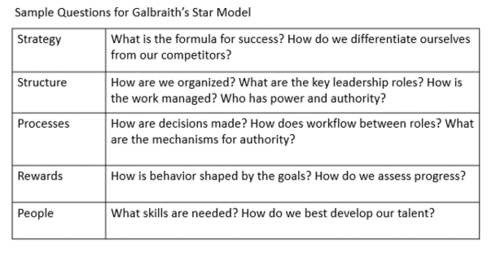The Star Model
The Star Model™ framework for organization design is "the foundation on which a company bases its design choices". The framework consists of a series of design policies that are controllable by management and can influence employee behavior. The policies are the tools with which management must become skilled in order to shape the decisions and behaviors of their organizations effectively.[1] Introduced in 1982, Galbraith’s Star Model is one of the most widely-used organizational design frameworks.
Components of The Star Model
What Comprises The Star Model[2]
The Star Model consists of five areas that should be connected and aligned to successfully shape the decisions and behaviors of your organization: Strategy, Structure, Processes, Rewards, and People. The business model is placed in the middle of the star as a "center of gravity" holding the five areas together. Decisions about the business model impact implementation across these five areas.

source: Strategyzer
- Strategy: An organization's strategy is defined by its vision, mission, and values as well as its goals and objectives. Strategy sets out the direction of the organization.
- Structure: An organization's structure determines the type and number of job specialties needed as well as decides the number of departments and people in each department. It dictates the placement and movement of power and authority, and is the basis for forming departments.
- Processes: Organizational processes are defined by the flow of information and decisions. Those flows can happen vertically or horizontally. Vertical processes deal with allocating funds and talent via budgeting and planning.
- Rewards: Reward systems align the goals of employees with the goals of the organization. The system must use appropriate incentives to motivate workers to do the right things to fulfill the strategic direction of the organization.
- People: An organization's human resource policies govern recruitment, promotion, rotation, training and development. Those policies are designed to produce the talent and build the capabilities necessary to execute the strategic direction of the organization. They must be in harmony with the other design areas.
These design elements affect the overall direction of the organization, the nature of leadership, the flow of information, and the competencies and motivation workers. Strategy is a multi-dimensional concept which can be defined in a number of different ways. In general, strategy is the means by which an organization intends on achieving its objectives and goals with respect to improving or innovating for competitive advantage. Leaders, in turn, develop and reinforce the organizational capabilities need for strategy attainment (Galbraith, 1995; Kates & Galbraith, 2007). Questions related to each of the variables in the model are shown in the Table below.

source: Organizational Intelligence Institute
The Star Model does not specify a specific performance outcome (e.g., organizational culture, performance, or effectiveness). However, Kates and Galbraith (2007) explain that the model is merely a framework for decision making on crucial design elements that can be directly controlled by upper management. Culture, for example, is vitally important for any organization, but cannot be directly controlled by management. Rather, culture is a manifestation or outcome of the specific design choices made in an organization. Likewise, individual, group, and organizational effectiveness and performance are considered a byproduct of the variables in the model. In short, the Star Model depicts the organizational design variables that can be directly controlled by the leadership in an organization. Kates and Galbraith (2007) emphasize the importance of alignment among the variables in the Star Model. They recommend conducting an assessment to determine whether the variables are aligned to support the overall strategy and execution. The Star Model and the notion of alignment suggest interdependencies among the design elements in the model. However, there are no implied causal relationships or directionality among the variables in the model. Rather, the variables are complimentary in that a change in one design element may affect another variable in the model.[3]
References
- ↑ Definition: What is Jay Galbraith's Star Model for Organization Design? Jay Galbraith
- ↑ What is the Star Model Comprised Of? Strategyzer
- ↑ Explaining The Start Model OI-Institute
